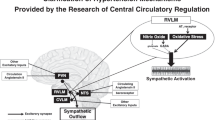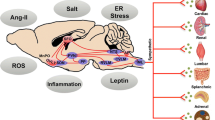Abstract
Paracrine signaling by nitric oxide (NO) released from microvasculature within the brain affects multiple neuronal functions. Reviewed here is a role in central cardiovascular control. Within the nucleus tractus solitarii (NTS), a major regulatory region for arterial pressure, angiotensin II stimulates NO generation from endothelial nitric oxide synthase (eNOS). This enhances γ-aminobutyric acid release to depress baroreflex function. In the spontaneously hypertensive rat (SHR), eNOS mRNA in the NTS is elevated compared to normotensive rats. Chronic inhibition of eNOS activity in the NTS of SHR reduced arterial pressure and increased baroreflex gain. Thus, eNOS-generated NO in the NTS plays a major role in control of baroreflex gain and arterial pressure. Indeed, its activity contributes to hypertension in the SHR. We propose that eNOS-generated NO in the SHR may be a compensatory mechanism for any potential threat to an adequate blood supply to the brain (eg, from genetically small arteries supplying the brainstem).
Similar content being viewed by others
References and Recommended Reading
Esler M, Kaye D: Sympathetic nervous system activation in essential hypertension, cardiac failure and psychosomatic heart disease. J Cardiovasc Pharmacol 2000, 35(Suppl 4):S1–S7.
Grassi G: Sympathetic and baroreflex function in hypertension: implications for current and new drugs. Curr Pharm Des 2004a, 10:3579–3589.
Grassi G: Counteracting the sympathetic nervous system in essential hypertension. Curr Opin Nephrol Hypertens 2004, 13:513–519.
Smith PA, Graham LN, Mackintosh AF, et al.: Sympathetic neural mechanisms in white-coat hypertension. J Am Coll Cardiol 2002, 40:126–132.
Smith PA, Graham LN, Mackintosh AF, et al.: Relationship between central sympathetic activity and stages of human hypertension. Am J Hypertens 2004, 17:217–222.
Grassi G: Role of the sympathetic nervous system in human hypertension. J Hypertens 1998, 16:1979–1987.
Guyenet PG: The sympathetic control of blood pressure. Nat Neurosci Rev 2006, 7:335–346.
Doba N, Reis DJ: Acute fulminating neurogenic hypertension produced by brainstem lesions in the rat. Circ Res 1973, 32:584–593.
Ciriello J: Brainstem projections of aortic baroreceptor afferent fibers in the rat. Neurosci Lett 1983, 36:37–42.
Paton JFR, Deuchars J, Ahmad Z, et al.: Adeno viral vector demonstrates that angiotensin II induced depression of the cardiac baroreflex is mediated by endothelial nitric oxide synthase in the nucleus tractus solitarii. J Physiol 2001, 531(Pt 2):445–458.
Paton JFR, Kasparov S, Paterson DJ: Site-specific differential modulation of cardiac autonomic control by nitric oxide. TINS 2002, 25:626–631.
Gross PM: Morphology and physiology of capillary systems in subregions of the subfornical organ and area postrema. Can J Physiol Pharmacol 1991, 69:1010–1025.
Millatt LJ, Abdel-Rahman EM, Siragy HM: Angiotensin II and nitric oxide: a question of balance. Regul Pept 1999, 81:1–10.
Paton JFR, Kasparov S: Differential effects of angiotensin II on cardiovascular reflexes mediated by nucleus tractus solitarii: a microinjection study in the rat. J Physiol 1999, 521.1:213–225.
Boscan P, Allen AM, Paton JFR: Baroreflex inhibition of cardiac sympathetic outflow is attenuated by angiotensin II in the solitary tract nucleus. Neuroscience 2001, 103:153–160.
Paton JFR, Lonergan T, Deuchars J, et al.: Detection of angiotensin II mediated nitric oxide release within the nucleus of the solitary tract using electron-paramagnetic resonance (EPR) spectroscopy. Auton Neurosci 2006, 126–127:193–201.
Wong LF, Polson JW, Murphy D, et al.: Genetic and pharmacological dissection of pathways involved in the angiotensin II-mediated depression of baroreflex function. FASEB J 2002, 16:1595–1601.
Kasparov S, Murphy D, Paton JFR: Plausible sources of nitric oxide released by angiotensin II in nucleus tractus solitarii. J Physiol 2001, 533:86P.
Kantor DB, Lanzrein M, Stary SJ, et al.: A role for endothelial NO synthase in LTP revealed by adenovirus-mediated inhibition and rescue. Science 1996, 274:1744–1748.
Lonergan T, Teschemacher AG, Hwang DY, et al.: Targeting brain stem centers of cardiovascular control using adenoviral vectors: impact of promoters on transgene expression. Physiol Genomics 2005, 20:165–172.
Dinerman JL, Dawson TM, Schell MJ, et al.: Endothelial nitric oxide synthase localized to hippocampal pyramidal cells: implications for synaptic plasticity. Proc Natl Acad Sci U S A 1994, 91:4214–4218.
O’Dell TJ, Huang PL, Dawson TM, et al.: Endothelial NOS and the blockade of LTP by NOS inhibitors in mice lacking neuronal NOS. Science 1994, 265:542–546.
Doyle CA, Slater P: Localization of neuronal and endothelial nitric oxide synthase isoforms in human hippocampus. Neuroscience 1997, 76:387–395.
Caillol M, Devinoy E, Lacroix MC, et al.: Endothelial and neuronal nitric oxide synthases are present in the suprachiasmatic nuclei of Syrian hamsters and rats. Eur J Neurosci 2000, 12:649–61.
Seidel B, Stanarius A, Wolf G: Differential expression of neuronal and endothelial nitric oxide synthase in blood vessels of the rat brain. Neurosci Lett 1997, 239:109–112.
Topel I, Stanarius A, Wolf G: Distribution of the endothelial constitutive nitric oxide synthase in the developing rat brain: an immunohistochemical study. Brain Res 1998, 788:43–48.
Blackshaw S, Eliasson MJ, Sawa A, et al.: Species, strain and developmental variations in hippocampal neuronal and endothelial nitric oxide synthase clarify discrepancies in nitric oxide-dependent synaptic plasticity. Neuroscience 2003, 119:979–990.
James PE, Swartz HM: Simultaneous detection of pO2 and NO by electron paramagnetic resonance. Methods Enzymol 2002, 359:52–66.
Kasparov S, Paton JFR: Differential effects of angiotensin II in the nucleus tractus solitarius: plausible neuronal mechanism. J Physiol 1999, 521:227–238.
Wang S, Paton JFR, Kasparov S: Differential sensitivity of excitatory and inhibitory synaptic transmission to modulation by nitric oxide in the nucleus tractus solitarii. Exp Physiol 2007, 92:371–382.
Hirooka Y, Sakai K, Kishi T, et al.: Enhanced depressor response to endothelial nitric oxide synthase gene transfer into the nucleus tractus solitarii of spontaneously hypertensive rats. Hypertens Res 2003, 26:325–331.
Paton JFR, Deuchars J, Wang S, et al.: Nitroxergic modulation of visceral afferent signalling in the NTS. In Advances in Vagal Afferent Neurobiology. Edited by Undem BJ, Weinreich D. Boca Raton, FL: CRC Press; 2005:209–246.
Wang S, Teschemacher AG, Paton JFR, et al.: The mechanism of nitric oxide action on inhibitory GABAergic signaling within the nucleus tractus solitarii. FASEB J 2006, 20:E821–E831.
Paton JFR, Boscan P, Murphy D, et al.: Unravelling mechanisms of action of angiotensin II on cardiorespiratory function using in vivo gene transfer. Acta Physiol Scand 2001, 173:127–137.
Waki H, Murphy D, Yao S, et al.: Endothelial nitric oxide synthase in the nucleus tractus solitarii contributes to the hypertension in the spontaneously hypertensive rat. Hypertension 2006, 48:644–650.
Waki H, Kasparov S, Wong LF, et al.: Chronic inhibition of eNOS activity in NTS enhances baroreceptor reflex in conscious rats. J Physiol 2003, 546:233–242.
Cushing H: Concerning a definitive regulatory mechanism of the vaso-motor centre which controls blood pressure during cerebral compression. Bull Johns Hopkins Hosp 1901, 12:290–292.
Kumada M, Dampney RA, Reis DJ: Profound hypotension and abolition of the vasomotor component of the cerebral ischemic response produced by restricted lesions of medulla oblongata in rabbit. Relationship to the so-called tonic vasomotor center. Circ Res 1979, 45:63–70.
Braga VA, Paton JFR, Machado BM: Ischemia-induced sympathoexcitation in spinalyzed rats. Neurosci Lett 2007, 415:73–76.
Dickinson CJ: Neurogenic Hypertension: A Synthesis and Review. London: Chapman & Hall; 1991:123.
Dickinson CJ: The determinants of long-term blood pressure stability: control of trough blood pressure during sleep. J Hypertens 1998, 1:907–912.
Osborn JW; Hypothesis: set-points and long-term control of arterial pressure. A theoretical argument for a long-term arterial pressure control system in the brain rather than the kidney. Clin Exp Pharmacol Physiol 2005, 32:384–393.
Min J, Jin YM, Moon JS, et al.: Hypoxia-induced endothelial NO synthase gene transcriptional activation is mediated through the tax-responsive element in endothelial cells. Hypertension 2006, 47:1189–1196.
Dickinson CJ: Cerebral oxidative metabolism in essential hypertension: a meta-analysis. J Hypertens 1995, 13:653–658.
Zidek V, Fucikova A, Musilova A, et al.: Hematocrit and hemoglobin values are negatively correlated with insulin resistance in spontaneous hypertension. Folia Biol (Praha) 1999, 45:247–251.
Dickhout JG, Lee RM: Blood pressure and heart rate development in young spontaneously hypertensive rats. Am J Physiol 1998, 274:H794–H800.
Author information
Authors and Affiliations
Corresponding author
Rights and permissions
About this article
Cite this article
Paton, J.F.R., Waki, H., Abdala, A.P.L. et al. Vascular-brain signaling in hypertension: Role of angiotensin II and nitric oxide. Current Science Inc 9, 242–247 (2007). https://doi.org/10.1007/s11906-007-0043-1
Published:
Issue Date:
DOI: https://doi.org/10.1007/s11906-007-0043-1




